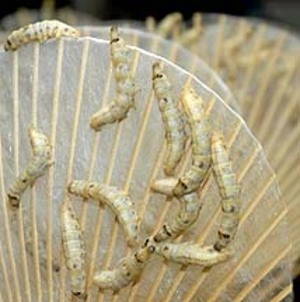

夏も本番!うちわを新調しようと思い、今年は「まゆうちわ」を使ってみることにしました。
お蚕さんが作るまゆうちわ。このうちわは、加工しても繋ぎ目がなく、光を渦状に反射させるのが特徴です。絹糸が美しく透け、見る人の心を癒してくれそうです。2番目の写真(工程中)は、うっ・・・と思いますが、出来上がってみれば日本の伝統美を代表するような繊細な絹製のうちわ。和紙を切り抜く紋きりを貼り付けて、自分だけのオリジナルまゆうちわを作っても楽しそうです。
現在、まゆうちわは、岐阜県と高知県(こなぎの会)で作られています。
岐阜県では、まゆうちわは、「久瀬のまいおどり」と呼ばれ、伝統工芸品のひとつです。糸を吐き始めた蚕は、自分の周りを囲うように卵型の繭を作ります。養蚕農家が、まぶしといわれる繭を作る巣から落ちた蚕が、紙状の繭(平面繭)を作ることに気がつき、 この蚕の特性を生かした平面繭で作られているそうです。
うちわの枠組みに置かれた蚕は、八の字を描くように糸を吐き続けます。うちわは5頭の蚕で、3日間ほどかけて作られます。
That silkworms spin silk fiber to produce oval cocoons is well known. A silkworm breeder found a caterpillar, which fell from the breeding box, making a plane cocoon on the ground. This very unique characteristic of silkworms is utilized to producesilk worm products.
Silkworms are placed on a bare frame of the fan or lantern and they start spinning silk fiber along the framework in the shape of number 8. Five caterpillars are needed to complete a fan and it takes three days for 50 caterpillars to finish a lantern. The seamless surface of the products reflects light in spiral shape and transparency of silk worm products would comfort our mind.
最近のコメント